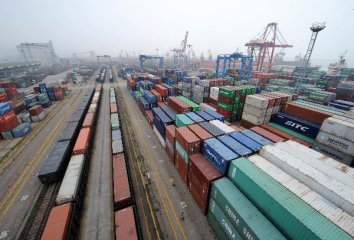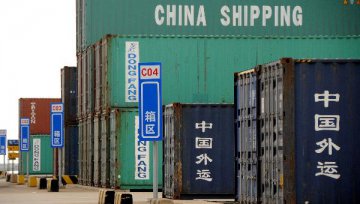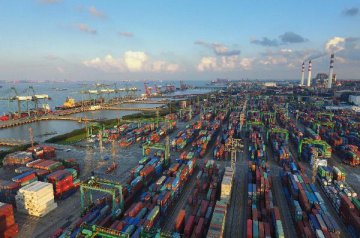
China's foreign trade dropped 4.5 percent year on year to 2.16 trillion yuan (337 billion U.S. dollars) in November, the ninth-consecutive monthly decline, official data showed Tuesday.
The level of decline in November significantly contracted when compared with the 9 percent year on year plunge registered in October, helped by increased electrical exports, data from the General Administration of Customs (GAC) showed.
Exports dropped by 3.7 percent, a fifth straight month of decline, to 1.25 trillion yuan and imports fell for the 13th consecutive month by 5.6 percent to 910 billion yuan. The trade surplus expanded by 2 percent to 343.1 billion yuan. In the first 11 months, foreign trade dropped 7.8 percent year on year to 22.08 trillion yuan.
They were separated into 12.71 trillion yuan for exports, down 2.2 percent; and 9.37 trillion yuan for imports, down 14.4 percent. Meanwhile, the trade surplus surged 63 percent to 3.34 trillion yuan.
China reported 3.16 trillion yuan worth of trade with the European Union, its largest trade partner, in the first 11 months, down 7.7 percent year on year; 3.15 trillion yuan with the United States, the second-largest trade partner, up 1.9 percent, according to the GAC. Trade with ASEAN, the third-largest trade partner, and the fifth trade partner Japan, dropped 2.1 percent 10.4 percent year on year, to 2.6 trillion yuan and 1.57 trillion yuan.
Foreign trade of private firms dropped 1.8 percent year on year in the first 11 months to 8.11 trillion yuan, accounting for 36.7 percent of China's total trade volume during the period. The weighting was 2.2 percentage points more than the same period last year.
Exports of private firms rose 2.2 percent year on year to 5.7 trillion yuan. In contrast, state-owned enterprises witnessed a sharp foreign trade fall of 12.9 percent year on year to 3.65 trillion yuan, accounting for 16.5 percent of the country's total during the period. Zhang Shuyu, a researcher with the University of International Business and Economics, said "low commodity prices, sluggish external and internal demand were to blame for the trade decline."
ELECTRICAL EXPORTS SHINE
Zhang highlighted increased mechanical and electrical product exports during the first 11 months, quoting media reports that China had overtaken Japan as Asia's largest exporter of high-tech products in 2014.
Of all Asian countries, China's share of high-tech exports hit 43.7 percent last year. Exports of mechanical and electrical products increased 1 percent to 7.32 trillion yuan, accounting for 57.6 percent of China's total exports in the first 11 months.
Of these products, mechanical exports dropped 8.1 percent year on year while electrical products rose 5.2 percent. In contrast, exports of seven traditional labor-intensive products dropped 2.6 percent to 2.64 trillion yuan, accounting for 20.8 percent of the total exports during the Jan.-Nov. period. Clothing exports led the drop with a 7 percent year on year decline.
China imported more iron ore, crude oil, grain and refined oil products in the first 11 months than the same period last year, while it imported less coal and steel products. "Challenges will remain for Chinese trade given sluggish global growth and low commodity prices," according to Zhang.
"HARD LANDING" UNLIKELY
Deng Haiqing, chief economist with JZ Securities said that "although both exports and imports were still in the negative growth arena, the performance was better than October as the decline contracted."
The U.S. dollar may end its strengthening period, making a rebound of commodity prices possible. On Tuesday, the central parity rate of the Chinese currency renminbi, or the yuan, weakened by 93 basis points to 6.4078 against the U.S. dollar, hitting the lowest since August 27 this year, according to the China Foreign Exchange Trading System.
In a broad sense, "China looks most likely to muddle through rather than land hard. World trade indicators have improved marginally," according to a Fitch Ratings' report on "Global Economic Outlook" Tuesday. "Policy stimulus has been stepped up in the eurozone and China and global consumer spending growth is holding up." Fitch said.
The State Council has rolled out a series of policies to boost foreign trade, including launching free trade zones and cross-border e-commerce pilot areas. The Fitch report further forecast world GDP to grow by 2.6 percent in 2016 and 2.7 percent in 2017, up from 2.3 percent this year.
The agency believed China have the administrative and financial resources to avoid a "hard landing" although the growth is slowing "as the economy works through protracted structural adjustment and rebalancing."























Latest comments